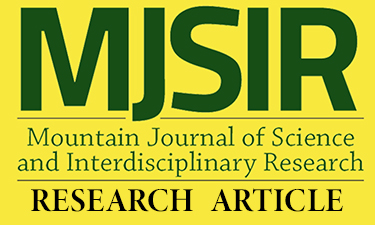Prevalence of Overweight and Obesity among Employees of Selected Regional Line Agencies in the Cordillera Administrative Region, Philippines
Main Article Content
Abstract
With the increasing trend of overnutrition, the implementation of appropriate nutrition action plan that is based on sound and extensive research data is being recommended. As part of developing an extensive health profile in Cordillera Administrative Region (CAR), Philippines, this study documented the prevalence of protein-energy malnutrition among the employees of 21 regional line agencies (RLAs) who are members of the Cordillera Regional Nutrition Committee (RNC). The study is a descriptive cross-sectional survey done among 395 permanent government employees. Data gathered were body mass index (BMI), waist circumference (WC) and waist-hip ratio (WHR). The employees were healthy, mostly non-pregnant females (65%) and selected through stratified random sampling. The mean BMI was 25.8 kg/m2 (males=26.5; females=25.4) indicating that the employees are generally overweight. The combined overweight and obesity prevalence was 56.7% with males registering a higher prevalence of 64% (n=79) compared to 52.7% (n=135) in females. The mean WC of 90.7cm for male and 83.7cm for female employees were within the borderline. WHR was 0.91 for males indicating absence of abdominal adiposity but 0.86 for females showing risk of increased metabolic complications. The overall prevalence of high WC was 26% (13.7% in the males and 32.8% in the females) while high WHR was 44% (17% males; 59% females). Exercise and length of service were correlated with BMI and WC. The high prevalence of overweight and obesity among the government workers puts them at risk of non- communicable chronic diseases. Appropriate health and nutrition policies and programs must be instituted at once.
Article Details
References
Apellido R. (2018). Night Shift Work and Weight Gain among Female Filipino Nurses. J Obes and Overweight 4(1): 10.
Asian Food Information Center. (2006, March 26). Food Facts Asia. 28: 2-7.
Bellosillo, A. (n.d). Facts and Information on Coronary Heart Disease and Fibre. Makati City: Foundation for Lay Education on Heart Diseases (FLEHD).
Brown, J.E. (2017). Nutrition in the Life Cycle. (6th ed). Boston, MA: Cengage Learning
De la Paz, C.R. (n.d). Screening for Overweight and Obesity in Adults. State of the Art of Obesity Research in the Philippines, 1998-2011. Pasay City.
Department of Health. (2018). What are the leading causes of mortality in the Philippines? Retrieved from https://www.doh.gov.ph/node/1058
Department of Health. (2010). Philippine National Guidelines on Physical Activity: Galaw Galaw Baka Pumanaw. Healthbeat. 58:9
Food and Nutrition Research Institute, Department of Science and Technology. (2015). Analysis of the Nutritional Status and Dietary Diversity of Filipino Households: Focus on the Fisherfolks. Taguig City, Philippines: FNRI-DOST.
Food and Nutrition Research Institute. (2015). Updating of the Nutritional Status of Filipino Children and Other Population Groups. Taguig City: FNRI-DOST.
Food and Nutrition Research Institute. (2016). Philippine Nutrition Facts and Figures: Anthropometric Data. Retrieved from http://enutrition.fnri.dost.gov.ph/site/preview. php?xx=%20uploads/2015_ANTHROPOMETRIC _SURVEY.pdf.
(n.d). Complications of Adult Obesity. In: State of the Art of Obesity Research in the Philippines, 1998-2011. Pasay City. Goodman, N. (2015). The Impact of Employment on the Health Status and Health Care Costs of Working-age People with Disabilities. A Policy Brief.
Harvard Medical School. (2015).The downside of too much sitting. April 15. Retrieved from https://www.health.harvard.edu
Harvard Medical School. (2017). Abdominal Obesity and Your Health. January 20. Retrieved from https://www.health.harvard.edu/staying- healthy/abdominal-obesity-and-your-health
Harvard Th. Chan School of Public Health. (n.d). Waist Size Matters. Retrieved from www.hsph.harvard.edu. Accessed on July 30, 2018.
Hume, P.A., & Ackland, T. (2017). Physical and Clinical Assessment of Nutritional Status. 4E. Retrieved from sciencedirect.com/topics/ agricultura-and-biological-sciences/ anthropometric measurements/pdf
Koster, A., Leitzmann, M., Schatzkin, A., Mouw, T., Adams, K., Van Eijk, J.Th.M., Hollenbeck, A., & Harris, T. (2008). Waist circumference and Mortality. American Journal of Epidemiology. 187 (12): 1465-147
National Institute of Health. (2000). The Practical Guide Identification, Evaluation, and Treatment of Overweight and Obesity in Adults. Washington, D.C.: National Heart, Lung and blood Institute. Downloaded from www.nhlbi. nih.gov/files/docs/guidelines/prctgd_c.pdf National Nutrition Council. (2015). Nutrition Month Talking Points. Taguig City, Philippines: NNC
Nelson, C.C., Wagner, G.R., Caban-Martinez, A.J., Buxton, O.M., Kenwood, C.T., Sabbath, E.L., & Sorensen, G. (2014). Physical activity and body mass index: the contribution of age and workplace characteristics. American Journal of Preventive Medicine, 46(3 Suppl 1): S42–S51. doi:10.1016/j.amepre.2013.10.035
Ng, M., Fleming, T., Robinson, M., Thomson, B., Graetz, N., & Margono, C. (2014). Global, regional and national prevalence of overweight and obesity in children and adults during 1980- 2013: A systematic analysis for the Global Burden of Disease Study. Retrieved from https:// www.thelancet.com/journals/lancet/article/ PIIS0140-6736(14)60460-8/fulltext.
Ruiz, A.J. (2010). Basic Nutrition for Filipinos. (6th ed). Manila: Merriam and Webster Bookstore. Stephenson, T.J., & Schiff, W.J. (2019). Human Nutrition. (2nd ed). New York: McGraw Hill Education
Wells, J.C. (2007). Sexual dimorphism of body composition. Best Pract Res Clin Endocrinology Metabolism. 21(3): 415-30. DOI: 10.1016/j. beem.2007.04.007
World Bank. (2006). Repositioning Nutrition as Central to Development A Strategy for Large-Scale Action. Retrieved from http:// siteresources.worldbank.org/NUTRITION/ Resources/281846-1131636806329/ NutritionStrategy.pdf
World Health Organization.(2011). Waist Circumference and Waist–Hip Ratio: Report of a WHO Expert Consultation, 8-11 December 2011. Geneva: WHO. Retrieved from http://apps.who.int/iris/bitstream/ handle/10665/44583/9789241501491_eng pdf;jsessionid=84E865C1EBBAD6F6FB64E6B46F284B6A?sequence=1
World Health Organization. (2019). Noncommunicable Diseases and their Risk Factors. April 2. Retrieved from www.who.int/ ncds/prevention/physical-activity/introduction/ en/World Health Organization. (2018) Global Health Observatory (GHO) data. Retrieved from http://www.who.int/gho/ncd/risk_factors/ overweight_text/en/.

